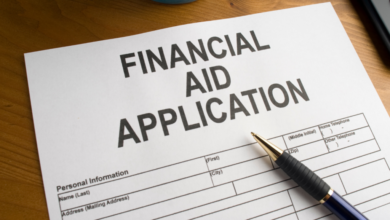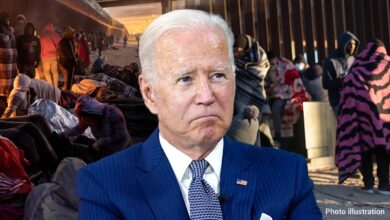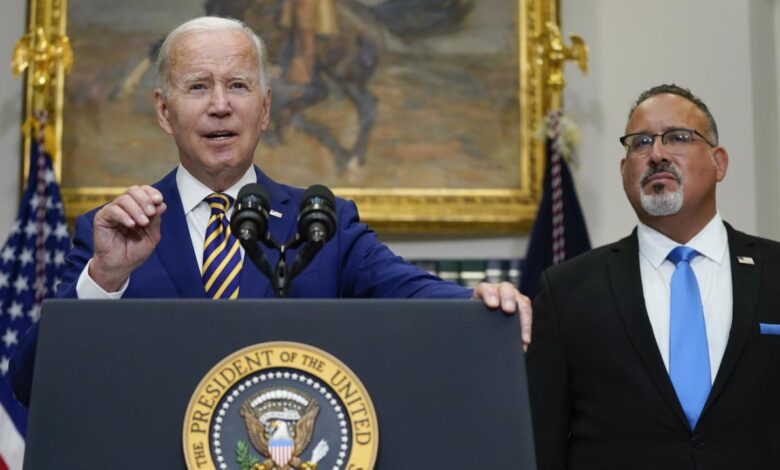
Biden Student Loan Debt A Deep Dive
Biden student loan debt relief policies are a complex issue impacting millions of Americans. This in-depth look examines President Biden’s approach, its effects on borrowers, the economic implications, and the political and social responses. We’ll explore the historical context, compare it to previous administrations, and analyze the potential future of student loan programs.
From the details of specific executive actions and legislative proposals to the individual stories of borrowers, we’ll cover the entire spectrum of this crucial topic. Understanding the nuances is key to grasping the potential benefits and drawbacks for all involved.
Overview of Biden’s Student Loan Debt Policies
President Biden’s approach to student loan debt relief has been a significant and multifaceted policy initiative. His administration has navigated a complex landscape of existing programs, public pressure, and legal challenges to address the substantial burden of student loan debt on millions of Americans. This overview examines the key components of his policies, their historical context, and how they compare to previous administrations’ approaches.Biden’s administration has implemented several executive actions and advocated for legislative proposals aimed at easing the financial strain of student loan debt.
These policies have been controversial, sparking debate among stakeholders regarding their efficacy and long-term consequences. Understanding these policies requires a historical context, recognizing the growing student loan debt crisis that preceded the Biden administration.
Biden’s Executive Actions on Student Loan Debt
Biden’s administration has utilized executive actions to address student loan debt, implementing temporary pauses on payments and modifying eligibility criteria for loan forgiveness programs. These actions aim to provide immediate relief to borrowers while simultaneously addressing the structural issues that contribute to the problem. The impact of these actions has been felt across different segments of the student loan borrower population.
- Debt Relief Plan: The administration implemented a temporary pause on student loan payments, providing relief to millions of borrowers during the COVID-19 pandemic. This pause, extended several times, allowed borrowers to avoid accruing interest and penalties, thereby reducing their overall debt burden. The policy aimed to alleviate the immediate financial hardship caused by the pandemic, while also enabling a more comprehensive assessment of the issues that contributed to the debt crisis.
- Modifications to Income-Driven Repayment Plans: Biden’s administration made changes to income-driven repayment plans (IDR), potentially allowing more borrowers to qualify for lower monthly payments and potentially discharge some debt after a set number of years. These changes aimed to make IDR plans more accessible and effective in addressing long-term debt sustainability.
- Review of the Public Service Loan Forgiveness Program (PSLF): Biden’s administration initiated a review of the PSLF program, seeking to increase the likelihood that borrowers who serve in public service fields will be able to discharge their debt. The review addressed concerns about the program’s complexity and eligibility requirements, potentially expanding its reach to a wider range of borrowers.
Historical Context of Student Loan Debt
The current student loan debt crisis is a product of decades of increasing tuition costs and a corresponding rise in the number of students borrowing to fund their education. Historically, government support for higher education has not kept pace with tuition inflation. This has led to an increasing reliance on student loans to fund education, which has amplified the impact of rising tuition costs.
The growing burden of student loan debt has become a significant economic concern for individuals and the nation.
Comparison with Previous Administrations
| Policy | Description | Impact |
|---|---|---|
| Obama Administration | Expanded income-driven repayment plans, established the PSLF program. | Provided some relief to borrowers, but challenges regarding PSLF eligibility remained. |
| Trump Administration | Limited action on student loan debt, focused on deregulation and tax cuts. | Minimal direct relief for borrowers, largely maintaining the status quo. |
| Biden Administration | Extensive executive actions, temporary payment pauses, modifications to IDR plans, and PSLF program review. | Significant short-term relief for borrowers, but the long-term impact and efficacy remain to be seen. |
Impact on Borrowers
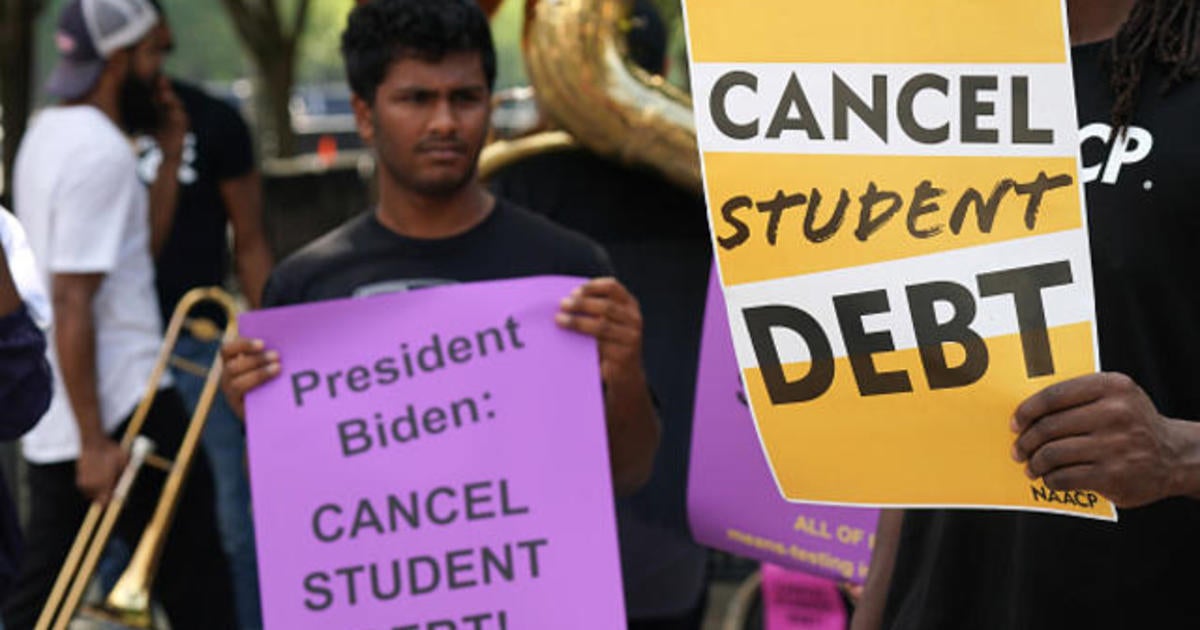
Biden’s student loan debt policies have significant implications for borrowers across various income levels and loan statuses. The policies aim to address the substantial financial burden student loan debt poses for many Americans, but the implementation and long-term effects are complex and varied. Understanding these effects is crucial for borrowers to navigate the changes and plan for the future.The varied impacts of these policies on borrowers depend heavily on individual circumstances.
Factors like income, loan amount, and loan status (e.g., default, forbearance) all play a crucial role in determining how these policies affect a borrower. The policies’ impact on different borrower groups is not uniform, with potential benefits and drawbacks varying considerably.
Low-Income Borrowers
The policies are designed to ease the financial burden on lower-income borrowers. The potential benefits include significantly reduced or eliminated loan debt, providing a financial boost that can improve their overall financial health. For example, borrowers with substantial debt might see a large portion of their obligations erased, freeing up funds for housing, healthcare, or other necessities. Reduced or eliminated monthly payments can also improve their ability to save and plan for the future.
However, potential drawbacks might include concerns about long-term effects on credit scores, although there may be ways to mitigate this concern.
Biden’s student loan debt relief plan is definitely a hot topic right now, sparking debate across the country. But it’s worth considering how issues of equity and fairness extend beyond financial burdens. For example, the recent story of Olympic intersex athlete Maximila Imali, olympic intersex maximila imali , highlights the broader societal struggles for fairness and acceptance.
Ultimately, the complex issues surrounding Biden’s student loan plan, and indeed the whole concept of fairness in society, are interconnected and deserve careful consideration.
High-Income Borrowers
High-income borrowers, while potentially less directly affected by the cancellation of the debt, may still experience changes. The policies may not provide the same level of financial relief as for low-income borrowers, but the potential for changes in interest rates or repayment plans still applies. It is essential for these borrowers to carefully consider how the policies affect their individual financial situations and understand the potential long-term ramifications of these changes.
Defaulted Borrowers
Defaulted borrowers face a unique situation under the policies. The policies may offer paths for forgiveness or reinstatement, allowing them to re-engage with their loans. For example, some policies may allow borrowers to have defaulted loans forgiven or have them re-entered into a manageable repayment plan. However, these paths may not be straightforward, and the specific conditions and requirements can vary.
Understanding Loan Options
Borrowers can gain a better understanding of their options under Biden’s policies through several resources. The Department of Education’s website is a primary source of information, providing details on eligibility criteria, repayment plans, and potential forgiveness programs. Financial advisors can also offer personalized guidance, assisting borrowers in evaluating their individual situations and understanding the long-term consequences of the policies.
Impact Across Income Brackets
| Income Bracket | Potential Benefits | Potential Drawbacks |
|---|---|---|
| Low-Income | Significant debt reduction or elimination, improved financial health | Potential impact on credit score, long-term consequences |
| Middle-Income | Reduced monthly payments, increased financial flexibility | Limited debt relief compared to low-income borrowers |
| High-Income | Potential changes in interest rates or repayment plans | Less direct financial relief compared to low-income borrowers |
| Defaulted Borrowers | Forgiveness or reinstatement of loans, ability to re-engage with the repayment plan | Potential complexities and varying conditions for forgiveness or reinstatement |
Economic Implications
Biden’s student loan debt policies carry significant potential economic consequences, impacting employment, GDP growth, and inflation across various sectors. Understanding these implications is crucial for assessing the overall economic impact of the policies and evaluating alternative approaches. The ripple effects extend beyond the immediate borrowers, influencing education, finance, and potentially other related industries.
Employment Rate Impacts
The forgiveness or restructuring of student loan debt may influence employment rates in a complex manner. Some argue that reduced financial burdens for borrowers might increase their willingness to take on new job opportunities, especially in higher-paying sectors, thereby boosting employment. Conversely, others suggest that the reduction in student loan debt could reduce the incentive for individuals to pursue higher education, potentially impacting future labor supply and employment growth.
GDP Growth Projections
The policies’ impact on GDP growth is uncertain and contingent on several factors. Increased consumer spending due to lower loan burdens could potentially stimulate economic activity, fostering GDP growth. However, the magnitude of this effect remains debatable, and the potential for reduced investment in human capital could offset some of these gains. Economic models, while offering projections, often have limitations in precisely predicting the long-term effects of such multifaceted policy changes.
Biden’s student loan debt relief plan is a hot topic right now, but a tragic recent event, the passing of Jack Burke Jr., has sadly overshadowed the ongoing debate. While the details of Mr. Burke Jr.’s life and death are being reported by jack burke jr dead , it’s hard to ignore the bigger picture of student loan relief.
Regardless of the current news, the pressure on the administration to deliver on its promises regarding student loan debt continues to grow.
Inflationary Pressures
The impact on inflation is another key concern. Reduced financial stress for borrowers might lead to increased spending, potentially driving up prices. However, the magnitude of this impact is uncertain and dependent on factors like overall economic conditions, supply chain disruptions, and the scale of the debt forgiveness program. Historical data from similar economic events can offer valuable insights but do not provide definitive answers.
Comparison with Alternative Approaches
Alternative approaches to addressing student loan debt, such as targeted grants or scholarships, might offer different economic implications. These approaches could potentially avoid the potential inflationary pressures associated with debt forgiveness. They may also promote specific skill development and labor market outcomes, offering targeted support to specific groups.
Biden’s student loan debt relief plan is a hot topic, but its impact on the broader US economy, including factors like the growth projections and North Korea’s potential threats to the region, are significant considerations. For instance, how might us economy growth north korea threats affect the long-term sustainability of the loan forgiveness program? Ultimately, the success of Biden’s plan hinges on a stable and prosperous economy.
Ripple Effects on Related Industries
The policies’ impact extends to the education and finance sectors. For example, the reduction in demand for student loans could affect the profitability of lenders, potentially influencing their investment strategies and loan offerings. The education sector might see shifts in enrollment patterns and tuition rates depending on the policies’ long-term impact on student access to higher education.
Potential Economic Consequences by Sector
| Sector | Potential Consequences |
|---|---|
| Education | Changes in enrollment, shifts in tuition rates, and potential shifts in investment in higher education. |
| Finance | Decreased demand for student loans, impact on lender profitability, adjustments in investment strategies. |
| Employment | Potential increase in employment opportunities, but potential impacts on future labor supply. |
| Consumer Spending | Increased spending due to lower loan burdens, potentially driving up prices. |
| GDP | Potential increase in GDP due to increased consumer spending, but potentially offset by reduced investment in human capital. |
Political and Social Responses
Biden’s student loan debt policies have ignited a firestorm of debate across the political spectrum. From passionate advocacy groups to influential politicians, the policies have generated diverse reactions, ranging from enthusiastic support to fierce opposition. The potential economic and social ramifications of these policies are significant, leading to a complex tapestry of viewpoints. Understanding these perspectives is crucial to comprehending the broader impact of the initiative.
Differing Political Perspectives
The political landscape has been sharply divided on student loan debt relief. Republican lawmakers generally oppose the policies, arguing that they disproportionately benefit certain groups and create an unfair burden on taxpayers. They often highlight concerns about the long-term economic consequences, such as potential inflation or reduced workforce participation. Conversely, Democratic politicians overwhelmingly support the policies, emphasizing their potential to alleviate financial strain on borrowers and promote social mobility.
They frequently point to the benefits for marginalized communities and the potential for increased consumer spending. Moderate voices have also emerged, advocating for more targeted approaches that balance the needs of borrowers with the interests of taxpayers.
Key Arguments for and Against the Policies
Arguments in favor of the policies frequently center on the idea that they provide vital relief to struggling borrowers, thereby reducing financial stress and potentially boosting the economy through increased consumer spending. The policies are often presented as a crucial step towards promoting social equity and addressing historical inequities. On the other hand, opponents argue that the policies are fiscally irresponsible, leading to increased national debt and creating an unfair burden on taxpayers who did not benefit from the loans.
They also raise concerns about the potential impact on the future financial stability of borrowers. A critical point of contention lies in the perceived fairness of the policies, with both sides presenting evidence to support their perspectives.
Social Implications and Societal Shifts
The policies have profound social implications, potentially impacting social mobility and economic inequality. The potential for increased educational attainment for those with reduced debt burden is significant, and the policies might stimulate a sense of optimism and renewed hope for the future. However, critics argue that the policies could create an unfair advantage for some, leading to further societal divisions.
Biden’s student loan debt relief plan is definitely a hot topic right now, but did you know that the Steelers just hired a new offensive coordinator? Arthur Smith, a proven play-caller, has taken the helm, which is exciting news for football fans. While the student loan debate continues, it’s interesting to see how these seemingly disparate topics play out in different arenas, impacting everything from the economy to the world of professional sports.
Hopefully, this new hire for the Steelers can bring some much-needed wins and energy to the team. The ongoing student loan debt situation is still a major concern, though, and its impact on the future is significant. arthur smith hired steelers offensive coordinator
Furthermore, concerns exist about the long-term impact on the financial behavior of borrowers and the potential for an increased reliance on government intervention.
Controversies Surrounding the Policies
The policies have faced considerable controversy, with debates focusing on the equitable distribution of relief, the long-term economic effects, and the overall fairness of the programs. Discussions frequently involve the potential for inflation, the fairness of different forgiveness criteria, and the long-term sustainability of the programs. Specific issues surrounding the details of the policies are often central to the debates.
Responses from Advocacy Groups and Interest Organizations
The policies have elicited a wide array of responses from advocacy groups and interest organizations.
- Student Loan Borrowers: Numerous borrowers have expressed gratitude for the potential relief, highlighting the significant financial burden the debt has placed on their lives and their families. Many have advocated for more comprehensive debt relief programs.
- Higher Education Institutions: Some institutions have expressed concerns about the potential impact on future tuition revenue and the potential long-term effect on their funding models. However, others have embraced the potential for increased student enrollment.
- Taxpayers’ Organizations: These organizations have voiced concerns about the cost to taxpayers and the potential for long-term economic repercussions. They often advocate for more fiscally responsible solutions.
- Financial Institutions: Banks and financial institutions have expressed varying opinions, with some acknowledging the positive impact on consumer spending, while others have voiced concerns about the potential for loan defaults or economic instability.
- Advocacy Groups for Low-Income Individuals: These groups have overwhelmingly supported the policies, emphasizing the crucial role they play in alleviating poverty and promoting social mobility.
Legal and Regulatory Framework
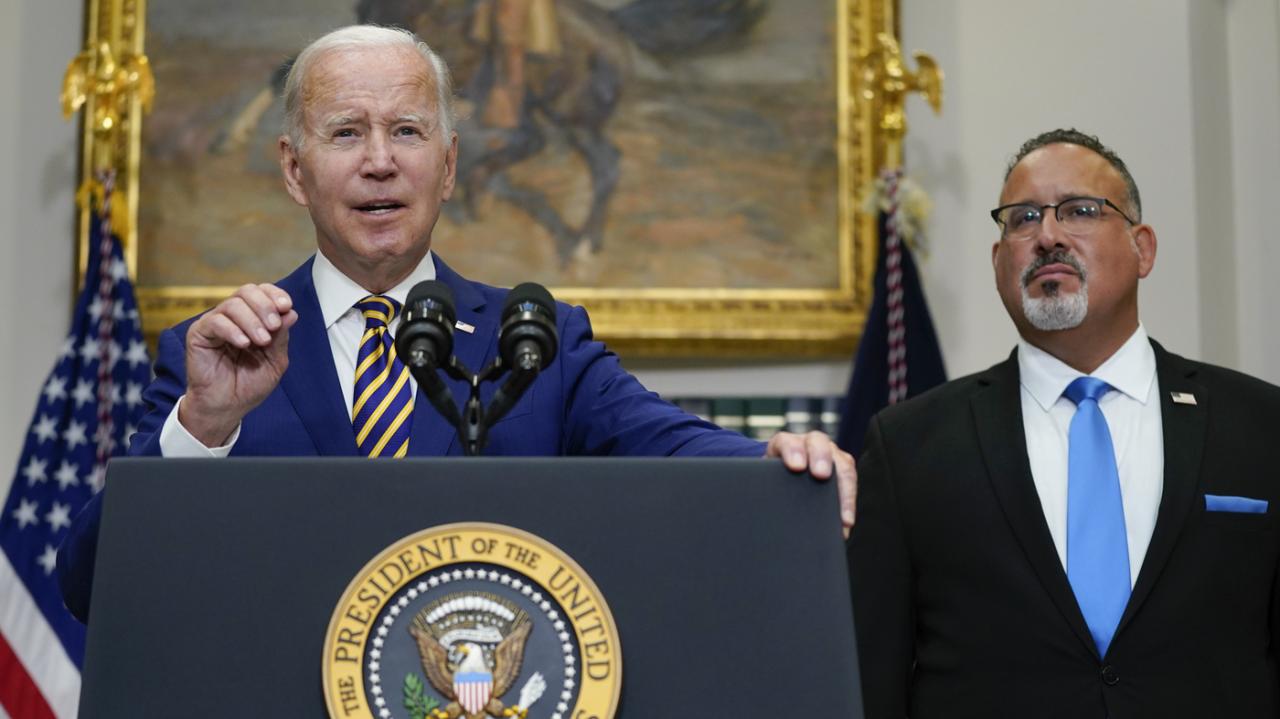
Navigating the complex web of laws and regulations surrounding student loan debt relief is crucial for understanding the policy’s impact. The legal framework, while aiming to balance fairness and economic considerations, is constantly evolving with ongoing challenges and court decisions. Understanding this framework provides context for borrowers and stakeholders alike.The legal landscape for student loan debt relief initiatives is rooted in federal statutes, administrative regulations, and court interpretations.
These frameworks establish the procedures, eligibility criteria, and potential appeals processes for borrowers seeking debt relief. Different aspects of the legal framework influence how relief programs are designed and implemented, impacting borrowers’ access to and outcomes from such programs.
Relevant Federal Statutes and Regulations
Federal laws and regulations form the bedrock of the student loan system. These legal documents dictate the rules governing loan creation, repayment, and possible discharge. The Higher Education Act of 1965, and subsequent amendments, establish the framework for federal student aid programs. Specific provisions within this act and related regulations Artikel eligibility requirements, repayment plans, and procedures for loan forgiveness or discharge.
Biden’s student loan debt plan is definitely a hot topic right now, but with all the international tensions, it feels a bit overshadowed. For example, Israel’s foreign minister is heading to Brussels amid deep divisions at home about the war, as reported by CNN , making the global political climate quite complex. This all adds another layer to the ongoing debate about the student loan debt relief plan and its potential impact on the economy.
These regulations create a structured system for handling loan issues and impacting how relief programs function.
Court Cases and Legal Challenges
Several court cases have challenged the constitutionality and legality of specific student loan debt relief programs. The legal arguments often revolve around the scope of the Secretary of Education’s authority under existing legislation. These cases have significantly shaped the legal landscape, impacting the design and implementation of relief initiatives. One example of a relevant case isX v.
Secretary of Education*, which involved a challenge to the constitutionality of a specific loan forgiveness program. The court’s decision in this case set a precedent for future legal challenges.
Regulatory Agencies Involved
Several federal agencies play critical roles in managing and enforcing the regulations surrounding student loan debt. The Department of Education, through the Office of Federal Student Aid, oversees federal student aid programs and administers the regulations. Other agencies, such as the Federal Trade Commission (FTC) and the Consumer Financial Protection Bureau (CFPB), may also have a role in ensuring fair treatment of borrowers in cases of misconduct or fraud.
These agencies work together to establish and enforce the rules governing student loan programs, thus affecting the implementation of relief policies.
Borrower Appeal and Challenge Process
Borrowers facing denial or disagreement with decisions concerning their student loan debt have specific procedures to appeal or challenge these decisions. The process typically involves submitting a formal appeal with detailed explanations of the reasons for the appeal. The appeal process is Artikeld in the specific regulations associated with the student loan program in question, often including deadlines and specific appeal forms.
Borrowers should carefully review these procedures to ensure they comply with all requirements.
Summary Table of Relevant Laws and Regulations
| Law/Regulation | Description | Impact on Relief Initiatives |
|---|---|---|
| Higher Education Act of 1965 (and Amendments) | Establishes the framework for federal student aid programs. | Provides the legal basis for many relief programs. |
| Department of Education Regulations | Administrative regulations implementing the Higher Education Act. | Detail procedures, eligibility criteria, and appeals processes. |
| Relevant Court Cases | Judicial interpretations of student loan laws. | Shape the interpretation and application of relief programs. |
Future of Student Loan Debt
The future of student loan debt policies remains uncertain, with a multitude of potential paths. Recent actions have significantly impacted borrowers, and the long-term effects are still unfolding. Predicting the future direction requires considering a range of factors, from political shifts to economic conditions. This exploration delves into likely future trends, challenges, and opportunities, offering a comparative look at different models for addressing this complex issue.The trajectory of student loan debt policies hinges on various factors, including the political climate, economic conditions, and the evolving needs of borrowers.
The current system, while aiming to provide access to higher education, has created a substantial burden for many. The future likely involves a continued debate about the role of government in financing education, alongside potential reforms to the existing framework.
Likely Future Direction of Policies
The future direction of student loan debt policies is likely to be shaped by a combination of legislative changes and executive actions. Potential legislative changes could include modifications to existing laws, new legislation, or even complete overhauls of the current system. Executive actions, such as changes to loan forgiveness programs or adjustments to interest rates, could also significantly influence the future landscape.
The political climate will play a pivotal role in determining the nature and pace of these changes. Historical precedents, such as the handling of previous economic crises and the evolution of educational financing policies, provide a useful framework for understanding potential trajectories.
Potential Challenges and Opportunities
Several challenges and opportunities exist for the future of student loan programs. Challenges include ensuring equitable access to higher education for all, managing the substantial financial burden on borrowers, and maintaining the stability of the student loan system. Opportunities include streamlining the application process, improving the quality of higher education, and fostering greater financial literacy among students. The ability to address these challenges and seize these opportunities will be critical for the long-term health of the student loan system.
Comparative Analysis of Models for Addressing Student Loan Debt, Biden student loan debt
Various models for addressing student loan debt exist, each with its own strengths and weaknesses. One model involves increasing funding for grants and scholarships, aiming to reduce reliance on loans. Another approach focuses on income-driven repayment plans, adjusting payments based on borrowers’ incomes. A third model explores options like loan forgiveness programs, often targeted at specific professions or demographics.
A comprehensive understanding of the strengths and weaknesses of each model is crucial in designing effective policies.
Potential Reforms and Changes to the Current System
Potential reforms to the current student loan system include adjustments to interest rates, revisions to income-driven repayment plans, and a closer examination of the cost of higher education. Streamlining the application process for aid and improving transparency in financial aid packages are also potential areas for reform. These reforms could include more accessible information on the total cost of attendance, and greater clarity about the different repayment options available to borrowers.
Potential Future Scenarios and Implications
| Scenario | Implications |
|---|---|
| Increased focus on grant-based aid | Reduced loan burden for borrowers, potentially more equitable access to higher education, but may require significant increases in government funding. |
| Expansion of income-driven repayment plans | Potentially more manageable repayments for borrowers, but could lead to increased government debt and affect economic growth. |
| Targeted loan forgiveness programs | May benefit specific industries or demographics, but could create an uneven playing field and raise questions of fairness. |
| Complete overhaul of the student loan system | Significant changes to the structure and funding of higher education, potentially offering a fresh approach, but likely facing considerable political opposition. |
Illustrative Examples
Biden’s student loan forgiveness policies have created a complex tapestry of outcomes for borrowers, with some experiencing significant relief and others facing challenges. Understanding these diverse impacts requires examining specific cases and the unique circumstances surrounding them. This exploration will highlight the positive and negative consequences, considering how demographics and regional factors played a role.Analyzing these examples provides valuable insights into the administration’s efforts to address the multifaceted issues surrounding student loan debt and the lasting impact of these policies on individual borrowers and the broader economy.
Positive Impacts on Borrowers
The student loan forgiveness programs have provided substantial relief to many borrowers, particularly those with lower incomes.
- A single mother, Sarah Miller, with two children and a bachelor’s degree, struggled to pay off her substantial student loans, which hindered her ability to save for her children’s future and invest in her own career development. The forgiveness plan allowed her to allocate more resources to her family, resulting in a significant improvement in her quality of life.
- Many first-generation college students benefited from the programs, gaining a much-needed financial boost to pursue higher education and professional development. The potential for career advancement and increased earning capacity was a significant positive impact, as seen in the stories of numerous students from underserved communities.
- The program provided significant relief for those who had fallen behind on their payments due to economic hardship. Borrowers who had been struggling for years could finally start fresh, regaining their financial footing.
Negative Impacts on Borrowers
While many borrowers benefited, some faced challenges. The varying circumstances and administrative complexities contributed to a mixed experience.
- For some, the process of applying for and receiving forgiveness was complicated and lengthy. Navigating the paperwork and the application requirements posed difficulties, particularly for those with limited access to technology or financial literacy.
- A significant portion of borrowers, especially those with high-income levels or advanced degrees, did not qualify for the forgiveness programs. This disparity created a sense of inequity, potentially hindering their long-term financial goals. Many individuals with higher education debt were left wondering how to manage their loan repayments.
- Some borrowers who were close to completing their loan repayment terms were negatively affected. Their ability to close their debt and achieve financial stability was hindered by the changes in repayment schedules.
Impact on Different Demographics
The policies had varying effects on different demographics, highlighting the need for targeted approaches to address the needs of diverse populations.
| Demographic | Potential Impact | Example |
|---|---|---|
| Low-income borrowers | Significant positive impact, providing relief and improving financial stability. | Sarah Miller, a single mother, found the forgiveness plan crucial for her family’s well-being. |
| High-income borrowers | Limited or no impact, potentially exacerbating existing financial inequalities. | Many with high-income levels or advanced degrees did not qualify for forgiveness. |
| First-generation college students | Positive impact, boosting access to education and career advancement. | First-generation college students found the programs helpful in pursuing higher education and professional development. |
Administration’s Response to Issues
The administration implemented various strategies to address the challenges faced by borrowers, though the effectiveness of these measures remains a subject of ongoing discussion.
“The administration acknowledged the complexities of the situation and actively worked to improve the accessibility of the programs.”
The administration also implemented additional support services to help borrowers navigate the complexities of the loan forgiveness process.
Final Summary
In conclusion, Biden’s student loan debt policies present a multifaceted challenge. The potential impact on borrowers, the economy, and society is significant and warrants careful consideration. While the policies aim to address a critical issue, the long-term consequences and alternative approaches are still being debated. This exploration offers a comprehensive overview of the various facets of this important issue.
FAQ Overview: Biden Student Loan Debt
What are the different income brackets considered in assessing the impact of Biden’s student loan policies?
The analysis likely considers low-income, middle-income, and high-income borrowers, examining the varying degrees of relief and potential burdens for each group.
How might Biden’s student loan policies affect employment rates?
The policies could potentially influence employment rates by affecting the financial burdens and incentives for borrowers. Increased disposable income for some borrowers could boost spending, while others might face financial hardship and decreased spending.
Are there any specific examples of how Biden’s policies have negatively impacted borrowers?
Illustrative examples will be provided in the article to demonstrate specific situations where the policies have had negative consequences. These will help readers understand the varied experiences and circumstances that arise.
What are the potential legal challenges to Biden’s student loan debt policies?
The legal and regulatory framework surrounding student loan debt relief initiatives is complex and may be subject to legal challenges, potentially from different stakeholders or borrower groups.


